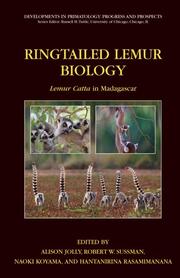Ringtailed Lemur Biology von Alison Jolly/Robert W Sussman/Naoki Koyama et al
Ringtailed Lemur Biology
Lemur catta in Madagascar, Developments in Primatology: Progress and Prospects
ISBN/EAN: 9780387326696
Sprache: Englisch
Umfang: xvi, 378 S., 118 s/w Illustr., 2 farbige Illustr.,
Einband: gebundenes Buch
Erschienen am
30.08.2006
Auf Wunschliste
This book is a truly international collaboration, with editors based on four con- nents and first authors from Canada, France, Japan, Madagascar, the United Kingdom, and the United States. Clearly, there is something attractive about studying Lemur catta, the ringtailed lemur. Perhaps it is the lemurs themselves! Why study ringtailed lemurs? Because lemurs are a separate radiation of p- mates from the monkeys, apes, and humans. Because ringtails live in the largest social groups of any known lemur and therefore offer the closest comparison with other social primates, including ourselves. And also because ringtails have become the flagship species of Madagascar. Some 70 species or subspecies of lemurs inhabit Madagascar. Each kind has its own fascinating story, but ringtails are the ones that everyone thinks they know. That black-and-white tail adorns tourist brochures and school notebooks and banknotes. All the same, after 40 years of field study, we don¿t know nearly enough. In this book, we make a first estimate on how many might be alive today, but we do not know how many ri- tailed lemurs and how many southern forests will survive. This book explores part of what we do know. Its four sections are (I) Distribution: Ringtailed Lemurs in Madagascar, (II) Ringtails and Their Forests: Feeding and Ranging Behavior, (III) Social Behavior Within and Between Troops, and finally (IV) Health and Disease. Of course, all these issues are int- related.
Alison Jolly was the first scientist to study ringtailed lemurs in the wild, beginning in 1963. She continues her research on their troops in Berenty Reserve, working with many colleagues and students. Robert Sussman began the survey of ringtails throughout Wesern Madagascar in 1970, and in 1979 co-founded Beza Mahafaly Reserve of the School of Agronomy, University of Antananarivo. He has also continued research with generations of western and Malagasy students since then. Naoki Koyama heads the Kyoto University study group on ringtail behavior at Berenty, 1989 to the present. Hantanirina Rasamimanana of the École Normale Supérieur, University of Antananarivo, first worked at Berenty in 1983, and continues research there with the ENS students. In short, the four editors head all the major ringtail research groups, and have united with their colleagues and students to write this volume.






